Intro
Some time ago, I was browsing some Internet when I believe I got and ad to a CNC milling machine from gearbest. It was 30% off and at time (140$, plus 40$ for shipping to Brazil) and it did seem to be a very good deal. I ended up buying it, but why would I even need one in first place?
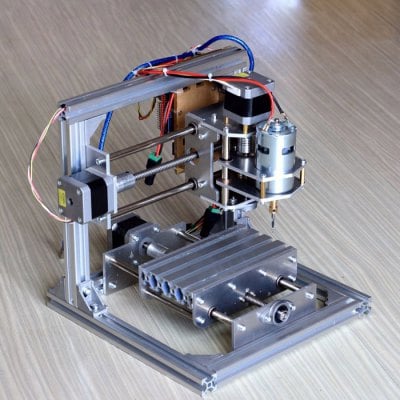
I have electronics as a hobby and probably as a trade in the future. I am a electrical engineering student, but never found electric power systems appealing. Thus, I spend more energy on programming, circuit design, analog electronics etcetera etcetera.
Nevertheless, I never had any reliable way of prototyping projects. Usually, as can be seem in many posts here, I frequently used veroboard to try out circuits. There are many problems to that:
- Too much soldering, and consequently, fumes;
- Can get very messy when using too many wires;
- Mainly through hole components.

All right, but I could use a laser printer and transfer method, but:
- I don’t have access to a laser printer, haven’t ever thought of buying one, as they are super expensive here;
- Nasty chemicals. A pleasure to use, clean and dispose;
- Need to drill holes anyway.
This is why a milling machine seemed a good option, I knew it had its drawbacks though:
- Dirt. The pcb materials can be very dangerous to inhale.
- Designing and milling a board can be time consuming, not very fast prototyping
I bought the machine as an impulse. When it arrived in Brazil, I was taxed 60% in customs. Still, I did not have the chance to regret it, as still seemed a fair deal. I could not find cnc machines as this one here, even from scalpers.
When I had the machine arrive at my door, it was not the model I bought originally, but seemed better quality (good for me).
I received the machine in January, but only now I could finish this write up. First, because it took me some time to get to know how to use it efficiently. Secondly because of college.
Just a quick note here:
I know that anyone can get cheap PCBs from china nowadays. But I live in Brazil, and just to receive this machine, it took me 70 days of waiting. I got some gifts from the Arduino team and they arrived in 128 days. Sometimes things take 6 months to arrive and these days I have seen people receiving stuff they bought in the last black friday in November. I won’t expect months for prototipe PCBs, so there is that.
Briefing
This CNC is sold as an engraving machine. Its frame is made of aluminum, so it is quite sturdy. Some people had luck using it for pcbs, and I can confirm it works fine. It is a bit small though.
- Work area: around 10*13cm, if you can get to hold the board all right, its own table is a little smaller than this.
- Technically, the package has everything you need (apart from computer software), even the power supplies. Yes, two of them. I changed some parts though.
- It uses GRBL 0.9 running on the cheapest arduino UNO board, also included.Already configured in my case.
- GRBL and the arduino shield have support to autolevel
- The spindle motor speed can’t be controlled. It is either on or off.
Assembling
C’mon, there are many tutorials for assembling it online. I don’t have a good camera anyway, so we will be skipping this. I will leave some links at the end of the article though.
Ah, there are not manuals or anything, just the parts. That’s what cheap gets you. Anyways, it is like pro lego, just put the parts together.
Fixes
The product page states:
“Modification and customization of the 3D printer is strictly forbidden. We will take no responsibility for any problems resulting from modifications.”
Funny. Go ahead.
All right, I think I assembled the machine as the manufacturers intended, but I did “some” tweaking to make it better
First, the most problematic, the Z axis:
- There were some standoffs included in the package for holding the pieces where the milling motor is mounted. They were thinner than the holes they were supposed to be fit into. This led to a lot of misalignment. I substituted then for screws with nuts, as can be seen below. I used a piece of metal to make sure the two parallel parts were perfectly aligned, just fit it between the two close to the screws and adjusted the nuts accordingly.
- There was a significant amount of play in the Z axis, this was due to some imperfection in the bushings on the said axis. I fortunately had some bushings from inkjet printers I disassembled before, so I replaced the originals with them. It worked fine.


The working area:
- The CNC table is tiny. It is actually smaller than the axis can go. I added a piece of scrap wood above the aluminum table, holding it with the original screws. I recommend you to use wood, as it can be drilled into without major problems if something goes wrong. Also, it isolates the PCB from the metal structure when auto-leveling.
Added auto-level:
- GRBL has support to auto-level, but the machine does not use it by default. I simply added jumper cables to pin A5 and GND and used alligator clip cables to extend them. It is important to make sure the positive lead is connected to the board and the negative one to the bit. The other way around the machine will mistakenly register false contacts.
Stepper config:
All my stepper motors look exactly the same, but one of them had a different label from the the other two. Thankfully I noticed this before assembling the machine. Thus, I used the different motor in the Z axis. Later, I noticed this motor was only moving half of what it was told to move, so I had to double the current number of steps per millimeter. This is quite easy, first open up the Arduino IDE and select the serial terminal (You can use other terminal too, help yourself).
Type $$ to see the current GRBL settings, mine were as follows:
$0=10 (step pulse, usec) $1=25 (step idle delay, msec) $2=0 (step port invert mask:00000000) $3=3 (dir port invert mask:00000011) $4=0 (step enable invert, bool) $5=0 (limit pins invert, bool) $6=0 (probe pin invert, bool) $10=3 (status report mask:00000011) $11=0.010 (junction deviation, mm) $12=0.002 (arc tolerance, mm) $13=0 (report inches, bool) $20=0 (soft limits, bool) $21=0 (hard limits, bool) $22=0 (homing cycle, bool) $23=0 (homing dir invert mask:00000000) $24=25.000 (homing feed, mm/min) $25=500.000 (homing seek, mm/min) $26=250 (homing debounce, msec) $27=1.000 (homing pull-off, mm) $100=800.000 (x, step/mm) $101=800.000 (y, step/mm) $102=800.000 (z, step/mm) $110=400.000 (x max rate, mm/min) $111=400.000 (y max rate, mm/min) $112=400.000 (z max rate, mm/min) $120=200.000 (x accel, mm/sec^2) $121=200.000 (y accel, mm/sec^2) $122=200.000 (z accel, mm/sec^2) $130=200.000 (x max travel, mm) $131=200.000 (y max travel, mm) $132=200.000 (z max travel, mm)
So I had to double the value of the 102 variable to compensate for the different motor, this was done simply typing “$102=1600.000” in the terminal. I received a “ok” as response. Typing $$ again, returned the following:
$0=10 (step pulse, usec) $1=25 (step idle delay, msec) $2=0 (step port invert mask:00000000) $3=3 (dir port invert mask:00000011) $4=0 (step enable invert, bool) $5=0 (limit pins invert, bool) $6=0 (probe pin invert, bool) $10=3 (status report mask:00000011) $11=0.010 (junction deviation, mm) $12=0.002 (arc tolerance, mm) $13=0 (report inches, bool) $20=0 (soft limits, bool) $21=0 (hard limits, bool) $22=0 (homing cycle, bool) $23=0 (homing dir invert mask:00000000) $24=25.000 (homing feed, mm/min) $25=500.000 (homing seek, mm/min) $26=250 (homing debounce, msec) $27=1.000 (homing pull-off, mm) $100=800.000 (x, step/mm) $101=800.000 (y, step/mm) $102=1600.000 (z, step/mm) $110=400.000 (x max rate, mm/min) $111=400.000 (y max rate, mm/min) $112=400.000 (z max rate, mm/min) $120=200.000 (x accel, mm/sec^2) $121=200.000 (y accel, mm/sec^2) $122=200.000 (z accel, mm/sec^2) $130=200.000 (x max travel, mm) $131=200.000 (y max travel, mm) $132=200.000 (z max travel, mm)
After this, I could move the Z axis for the correct length showed in bCNC.
Arduino and GRBL
Later I also replaced the Arduino with a better one and updated GRBL to 1.1, I had problems with the machine skipping steps, but I think it may have been the shield was not completely connected.
Next, I will use a design of mine as an example, a sort of tutorial. I will create the gerber files from eagle and then export the correspondent gcode to use with bCNC and explain all the steps.
Eagle and Flatcam
I use GNU/Linux, but I believe the software mentioned here is available for others systems, such as ridiculously expensive and just awful. Next, I will explain how to get a ready eagle board file for milling.
I have been using Eagle, mainly because it is easy, has good component libraries available online (see the adafruit and sparkfun ones), as is free for small boards. I run version 7 though, it is the last one before autodesk bought it and screwed it up. I plan to move to KiCad when I have time to study it, though.
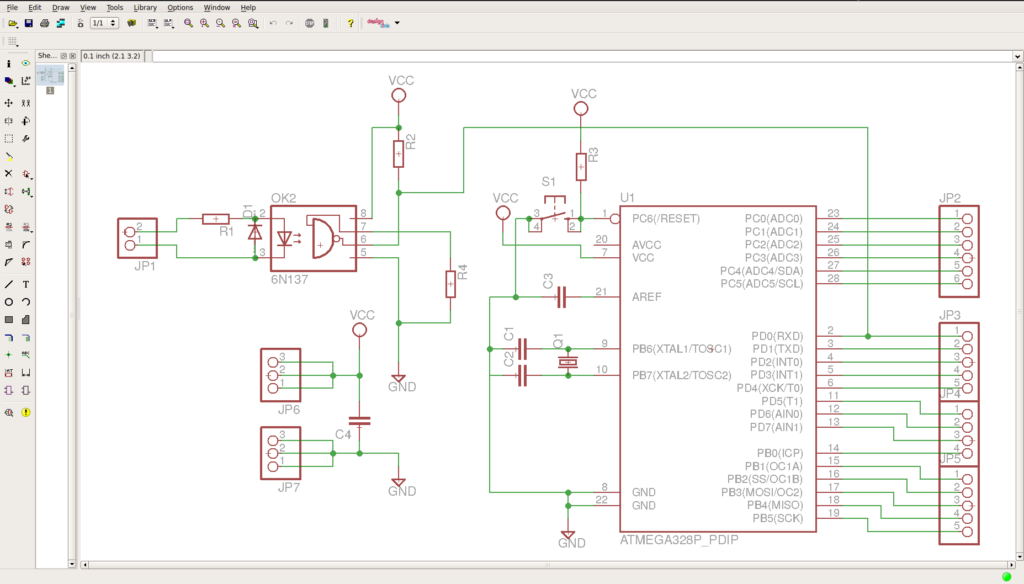

After I create a board using the board layout tools, I export the gerber files (File > CAM Processor).
I will be milling the bottom of a board, so the mirror option will be used. If the top layer is used, this option is not necessary, of course.
To export the milling file, select the layers Bottom (or top), Pads and Vias. Also select GERBER_RX274X as device and hit Process Job to generate the file.
To export the drilling (or excellon) file, select the layers Drills and Holes and then select EXCELLON_24 as device:
Now the milling options will be configured with flatcam.
Flatcam
Flatcam is used to configure the gcode files. First, we need to open both the gerber and excellon files.
I prefer to put the board as close as possible to the origin. This is helpful when milling a copper clad slightly bigger than your design, but not obligatory. For this, the offset option is used. In this case, I just moved the design -10 units to the bottom, in both files.
Now both files are close to the the origin:
Now, to the the milling file. Double click the gerber file and the tab Selected will show. Here I use a 0.1mm bit, with a single pass. You will see it worked fine, but it is recommended to increase the number of passes, otherwise you will probably have shorts when soldering.
After clinking generate geometry, a file with the same name, but finished in iso, will be created:
In this file, you will set up the other milling options. I use -0.1mm as cut depth; the tool will raise 5mm above the board when traveling; the feed rate I use 150 mm/s and again the bit diameter is also 0.1mm. I used 3000 rpm as spindle speed, but the machine does not have variable spindle speed, of course. This was necessary though, as the kit was configured to variable speed and expecting a speed value, otherwise the spindle won’t turn on.
You can recompile GRBL and update the arduino to use fixed spindle speed. Its is not trivial, so I will not be discussing it here, maybe in another post.
After clicking generate, we will have the cnc file.
Select the cnc file and export the gcode with a .nc extension.
Next, we have to configure the excellon file, click it to open the Selected tab.
In this file I only had two hole sizes. I should be all right using only a 1mm drill bit. So I selected both, If you have different hole sizes, you might have to create separate files for the correspondent drill bits.
I used 1.6mm as drilling depth, the thickness of the copper clad. 5mm traveling height and a slow feed rate of 75mm/s. You can’t increase the speed too much, or your drill bit might break. Click in generate to create the cnc file.
Click the cnc file and export it. I used the name holes.nc
Similarly, you can create a board cutout. Generate the geometry from the gerber file:
I don’t have a proper bit for cutting, so I use a regular engraving v bit to just score the board, so I can just snap it. The cutting depth used was 0.8mm, with a feed rate of 75mm/s.
Milling with bCNC
First I hold the board with a thick double sided tape. Be generous, otherwise the board may come loose and you will probably have to start again with a clean board. Ah, don’t forget to use a board that fits your design.
bCNC is used to mill and drill the board using the gcode files created with flatcam. First, open the serial port the cnc is connected to.
Move the tool to the bottom left corner of your copper board. The z axis must be barely be touching the board surface.
When finished, zero the three axes by clicking X=0, Y=0 and Z=0:
Next, open the nc file you want to mill.
Now it is time for auto-level. It defines the quality of the board, if done correctly, will guarantee a perfect routing. I made sure to get it working as soon as I assembled the machine. A CNC without auto-level may leave some parts of a board without milling, or go too deep when it should not. Usually copper clads have imperfections, or are visibly bent. The Autolevel routine measures the board surface height, taking these measurements into account when milling the board.
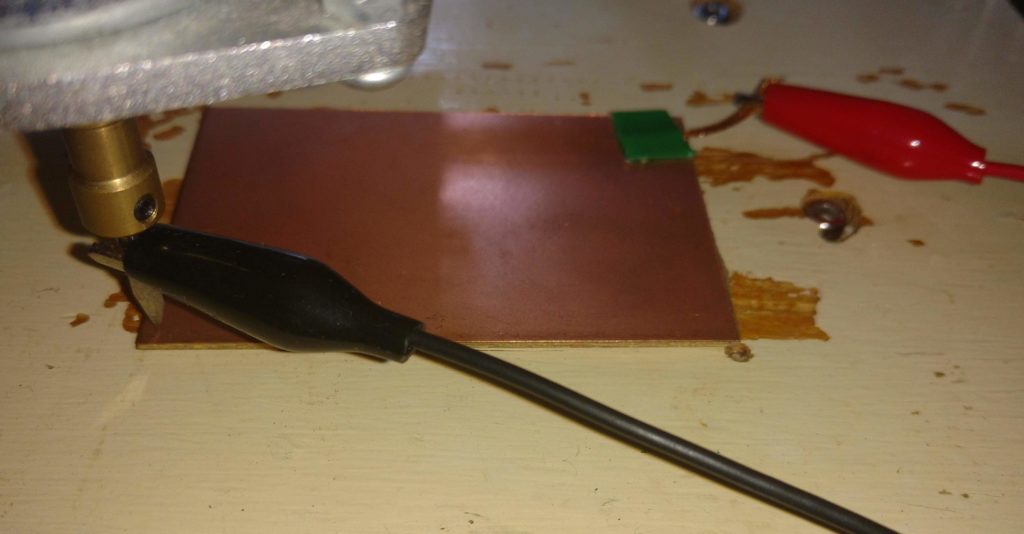
Click the Probe tab, then Autolevel. Click the margin button to select the scanning area. You can adjust the number of points by selecting N in the Autolevel panel at the left-hand side.
Also, it is very important to select the Z limits. I used a -2.0mm min value, so in case the probe does not find the board, the procedure will stop 2mm below zero, avoiding further damage.
When finished setting up the values, make sure your probes are connected correctly and hit scan.
When the auto leveling finishes, the working area will have been mapped as the figure bellow. This is the cutout file, but the calibration is the same. I forgot to take a snapshot with the other file.
Everything is read, the file can now be milled, but don’t forget to remove the auto level probe! I forgot once and the spindle rotated the probe cable making a mess.
To start the milling, just hit the play button in the Control tab.
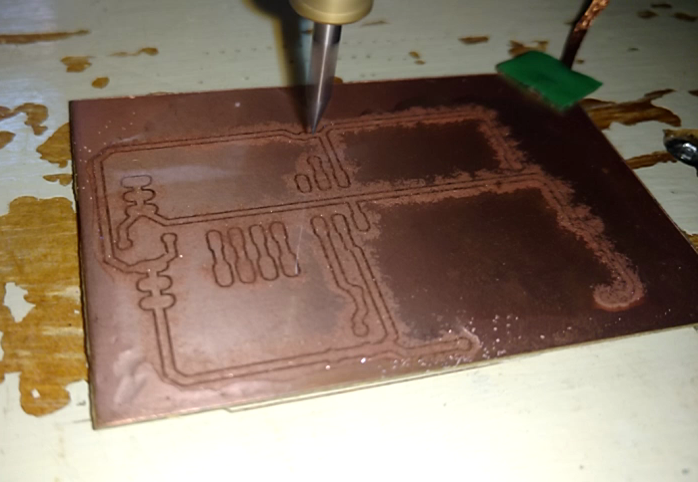
Finished the routing file, you can open the drilling file, keep the auto level measurements when asked. As the drilling generally is taller than the v cutting bit, the Z axis must be zeroed again:
Next picture shows the drilling process on bCNC.
Lastly, the cutout file is opened. The Z axis must be zeroed again.
If everything went ok, I should have a nice PCB now.
Final result
The board was milled without problems, as it can be seen below:
I just regret not increasing the pads. The board works perfectly anyway, I just had to be careful when soldering.
The finished board:
I created it to experiment with MIDI.
Can the CNC mill smd boards, though?

The video below has parts of the leveling, milling, and drilling processes. It can be seen that I pour machine oil over the board, the oil suspends the bakelite particles, stopping them from escaping to the air.
Conclusions
I am quite happy with the machine now, as now I have a way of making better prototypes. It took me some time to learn how to use it and to fix some issues, but now it is working better than I expected.
The construction of the machine is quite sturdy, and replacement parts are available if necessary. It uses an arduino board, which is super easy to update.
Having excellent quality software that works on Linux is a huge plus. But the software is also available to the other operational systems parodies.
Now, I only have to know how to make double sided PCBs :)
That’s it for now. Thanks for reading!
References:
T8 CNC product page – Gearbest
The cheaper model – Gearbest
T8 CNC Assembly – Sreenzone
Another T8 CNC Assembly – HomoFaciens
Eagle how to – Flatcam
Conecting GRBL – GRBL Wiki








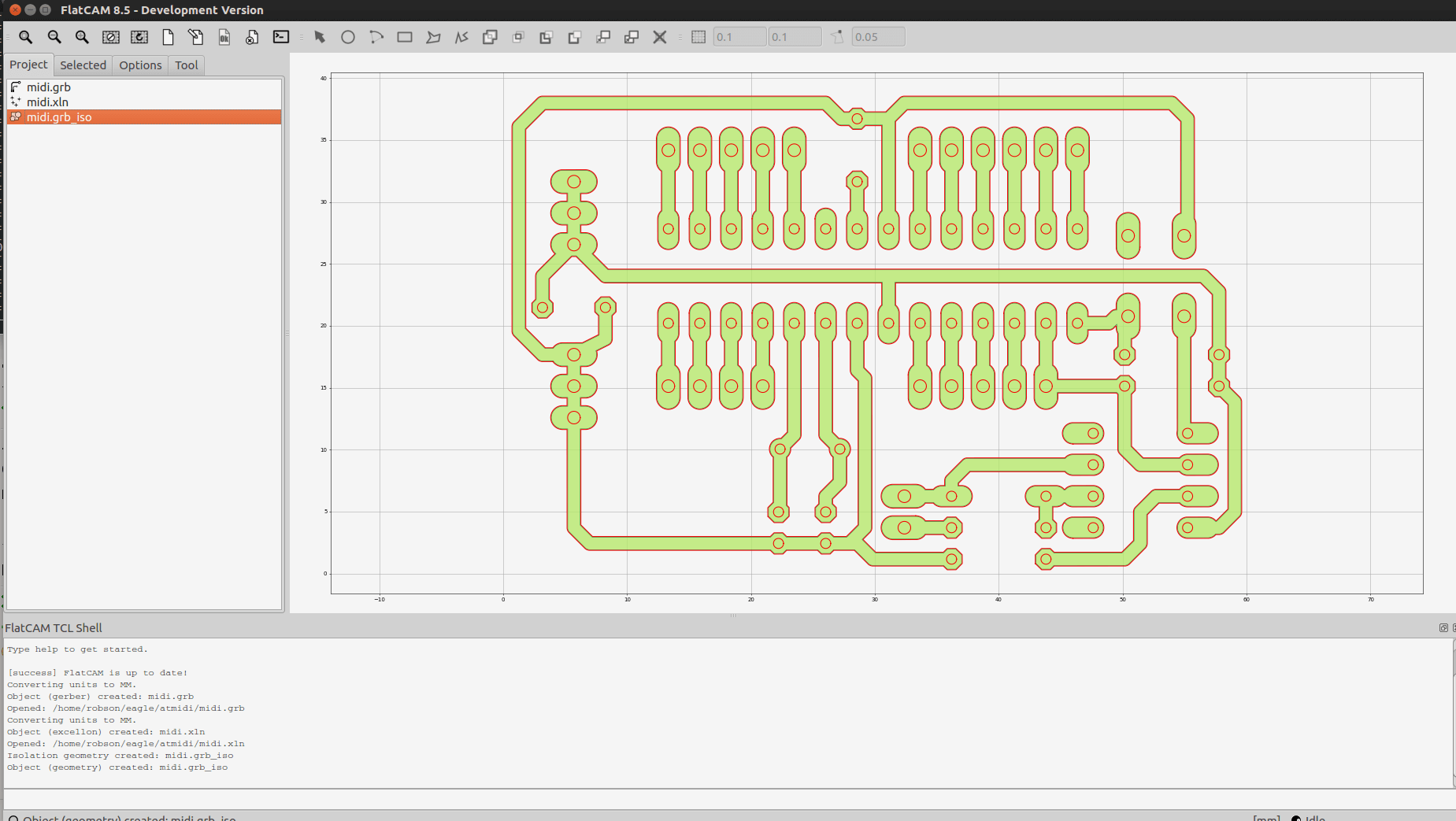





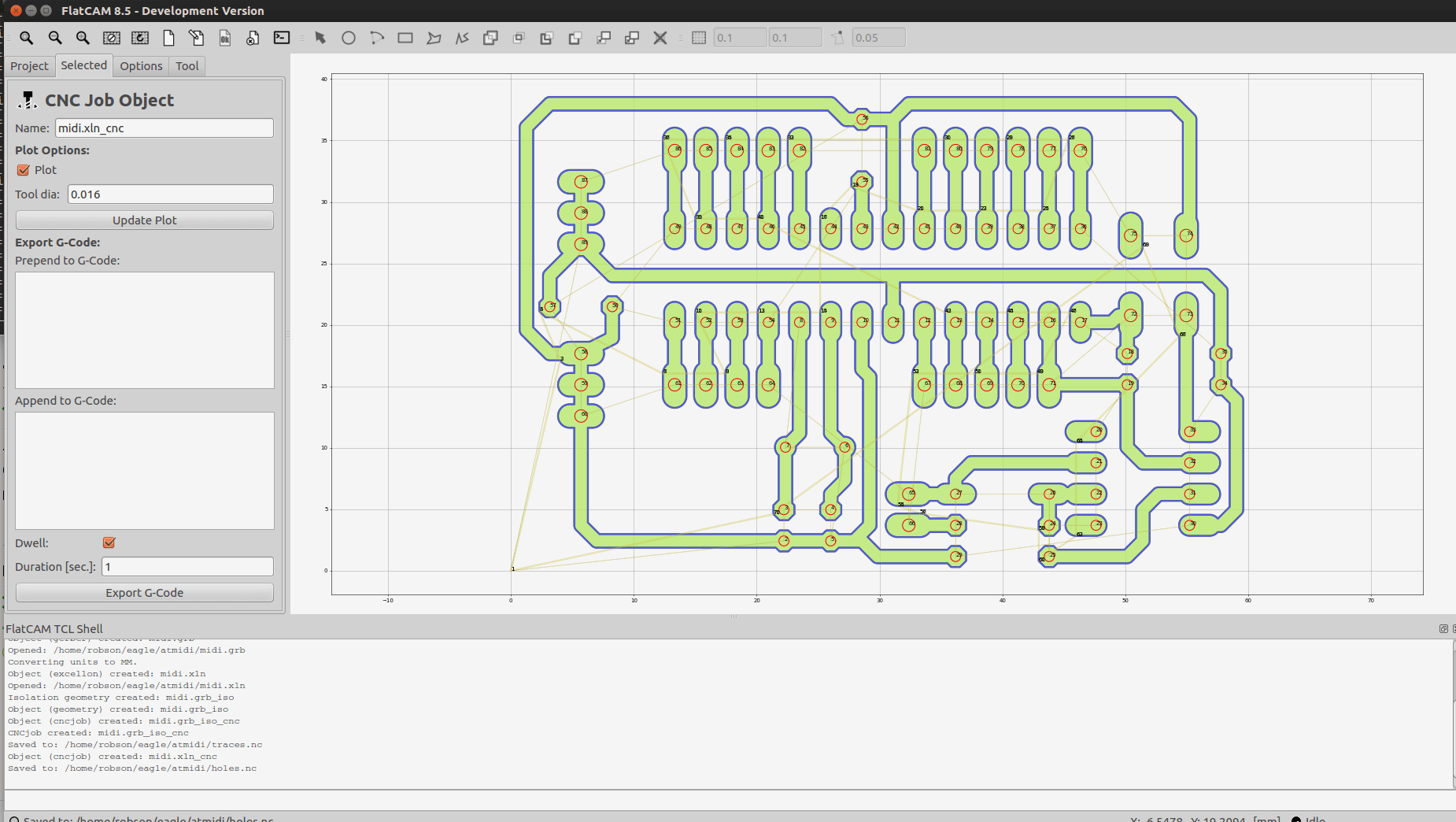



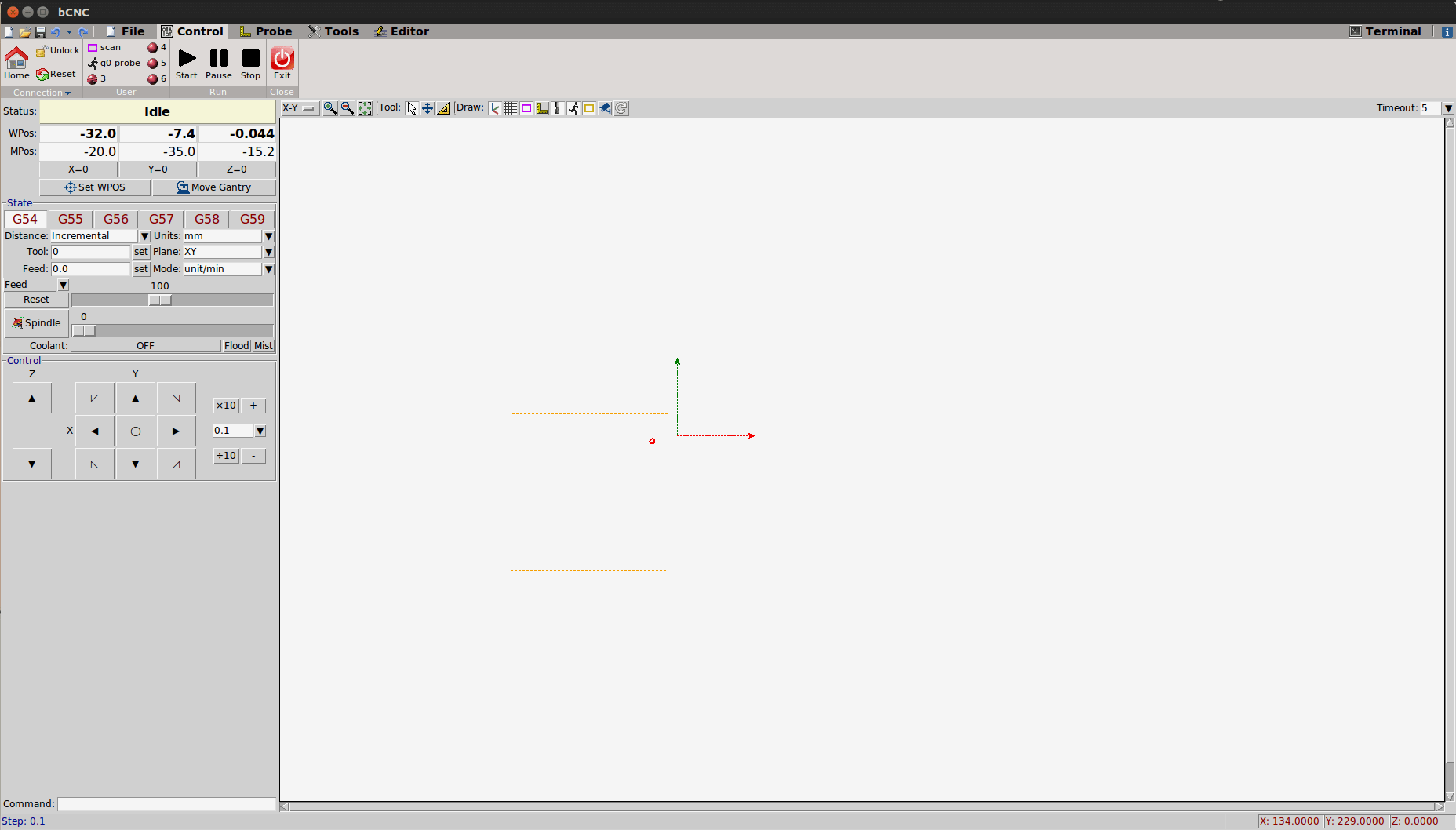










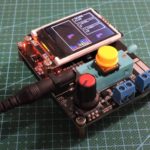


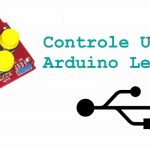

Excellent article! I’ve used many of the software that you mentioned, but instead of Eagle I used KiCAD. I did something similar for another cnc milling machine. Could you please explain how did you installed/compiled FlatCAM under linux. I used it but on Windows 7.
Hi Felipe ,sorry for the late reply, was not notified of your comment.
Very simple, the latest release can be downloade from https://bitbucket.org/jpcgt/flatcam/downloads/
Then I used setup_ubuntu.sh with:
$ sudo sh setup_ubuntu.sh
I guess this works with every debian based distribution, but I use Ubuntu anyways. If I am not wrong, this only installs dependencies, as flatcam can be run from the folder you downloaded with:
$python FlatCAM.py
I set up a shortcut with the command and stick it to the ubuntu sidebar for openning with a click when needed.
I had the same question. For my CNC PCB drilling experience, I used PCGtoGCode converter plug-in from Eagle. It works, but is tedious.
Hi Mike ,sorry for the late reply, was not notified of your comment as well.
As explained in the comment above:
Very simple, the latest release can be downloade from https://bitbucket.org/jpcgt/flatcam/downloads/
Then I used setup_ubuntu.sh with:
$ sudo sh setup_ubuntu.sh
I guess this works with every debian based distribution, but I use Ubuntu anyways. If I am not wrong, this just installs dependencies, as flatcam can be run from the folder you downloaded with:
$python FlatCAM.py
I set up a shortcut with the command and stick it to the ubuntu sidebar for openning with a click when needed.
Hi,
Firtsly, congrats for this awesome post.
I was thinking about buying a solution like this to make PCBs at home. Its not my job, only a hobby.
What is the diference between
T8 CNC product page – Gearbest
The cheaper model – Gearbest
??
When I change the plug for EU plug, its seems the same machine.
Thanks in advance.
Hi Soler
I guess the difference is just in the parts used. For example, the cheaper model uses rigid couplings instead of flexible ones. Also, some parts are made of plastic instead of brass. An amazing assembly guide of the cheaper CNC with a ton of pictures can be seen here: https://www.instructables.com/id/Mini-CNC-Engraver/
Hi, I gave up with my T8 CNC pcb milling project due to terrible runout on the stock spindle. Frustrating as it is 99% there! Any ideas or upgrades. Was thinking of using a drone motor like the Ant Mill. Cheers.
Hi Brad. Sorry, I have not upgraded mine, so I don’t have any recommendations. I could not find the “Ant Mill”, only the natural phenomenon where ants walk to death in a circle. The Other mill from Bantam Tools uses a brushless motor. I suppose one could also adapt something similar to the T8, but that would probably need custom 3D printed parts.
The Ant: https://www.youtube.com/channel/UCX44z-SSL7LzcB4xxgUdHHA/videos
That’s decent finish I guess.
Could you give me a recommendation of bit that you use, feedrate, and best track width that could be achieved?
Many thanks.
Hey nice tutorial it really help me!
just passing to say thanks!
I am glad it helped!
10TB ONLYFANS MEGA FOLDER ( https://urbancrocspot.org/ucs-leaks-archive/ )
11TB ONLY FANS MEGA LINK ( https://urbancrocspot.org/ucs-leaks-archive/ )
8TB ONLYFANS MEGA FOLDER ( https://urbancrocspot.org/ucs-leaks-archive/ )
10TB ONLYFANS MEGA FOLDER ( https://urbancrocspot.org/ucs-leaks-archive/ )
BUY FANSLY LEAKS ( https://urbancrocspot.org/ucs-leaks-archive/ )
10TB ONLYFANS MEGA FOLDER ( https://urbancrocspot.org/ucs-leaks-archive/ )
8TB ONLYFANS MEGA FOLDER ( https://urbancrocspot.org/ucs-leaks-archive/ )
6TB ONLY FANS MEGA LINK ( https://urbancrocspot.org/ucs-leaks-archive/ )
PURCHASE ONLYFANS MEGA LINKS ( https://urbancrocspot.org/ucs-leaks-archive/ )
PURCHASE ONLYFANS MEGA LINKS ( https://urbancrocspot.org/ucs-leaks-archive/ )
PURCHASE ONLYFANS MEGA LINKS ( https://urbancrocspot.org/ucs-leaks-archive/ )
BUY FANSLY LEAKS ( https://urbancrocspot.org/ucs-leaks-archive/ )
10TB ONLYFANS MEGA FOLDER ( https://urbancrocspot.org/ucs-leaks-archive/ )
Youre so cool! I dont suppose Ive read anything like this before. So nice to find somebody with some original thoughts on this subject. realy thank you for starting this up. this website is something that’s wanted on the internet, somebody with a little originality. helpful job for bringing something new to the web!
PURCHASE ONLY FANS LEAKS ( https://urbancrocspot.org/ucs-leaks-archive/ )
BUY ONLYFANS MEGA FOLDERS ( https://urbancrocspot.org/ucs-leaks-archive/ )
6TB ONLY FANS MEGA LINK ( https://urbancrocspot.org/ucs-leaks-archive/ )
Thanks for enabling me to achieve new tips about personal computers. I also have belief that certain of the best ways to keep your notebook computer in excellent condition is by using a hard plastic-type case, as well as shell, that fits over the top of one’s computer. A lot of these protective gear are model unique since they are manufactured to fit perfectly across the natural covering. You can buy them directly from owner, or via third party sources if they are available for your notebook computer, however don’t assume all laptop could have a spend on the market. Once again, thanks for your recommendations.
BUY ONLYFANS LEAKS ( https://urbancrocspot.org/ucs-leaks-archive/ )
PURCHASE ONLY FANS LEAKS ( https://urbancrocspot.org/ucs-leaks-archive/ )
PURCHASE ONLYFANS MEGA LINKS ( https://urbancrocspot.org/ucs-leaks-archive/ )
BUY FANSLY LEAKS ( https://urbancrocspot.org/ucs-leaks-archive/ )
ONLY FANS LEAKS TRADING ( https://urbancrocspot.org/ucs-leaks-archive/ )
8TB ONLYFANS MEGA FOLDER ( https://urbancrocspot.org/ucs-leaks-archive/ )
11TB ONLY FANS MEGA LINK ( https://urbancrocspot.org/ucs-leaks-archive/ )
BUY LEAKED ONLYFANS ( https://urbancrocspot.org/ucs-leaks-archive/ )
BUY ONLYFANS MEGA FOLDERS ( https://urbancrocspot.org/ucs-leaks-archive/ )
BUY ONLYFANS LEAKS ( https://urbancrocspot.org/ucs-leaks-archive/ )
I’m curious to find out what blog platform you’re working with? I’m experiencing some minor security problems with my latest blog and I would like to find something more safe. Do you have any suggestions?
8TB ONLYFANS MEGA FOLDER ( https://urbancrocspot.org/ucs-leaks-archive/ )
BUY ONLYFANS MEGA FOLDERS ( https://urbancrocspot.org/ucs-leaks-archive/ )
PURCHASE ONLYFANS MEGA LINKS ( https://urbancrocspot.org/ucs-leaks-archive/ )
12TB ONLYFANS MEGA FOLDER ( https://urbancrocspot.org/ucs-leaks-archive/ )
BUY ONLYFANS MEGA FOLDERS ( https://urbancrocspot.org/ucs-leaks-archive/ )
I do love the way you have presented this particular situation plus it really does offer me personally a lot of fodder for consideration. Nonetheless, from what precisely I have seen, I simply wish as the actual comments pack on that folks remain on point and don’t start upon a soap box associated with some other news of the day. Yet, thank you for this exceptional piece and even though I do not really concur with the idea in totality, I value your standpoint.
12TB FANSLY MEGA FOLDER ( https://urbancrocspot.org/ucs-leaks-archive/ )
12TB FANSLY MEGA FOLDER ( https://urbancrocspot.org/ucs-leaks-archive/ )
BUY ONLYFANS MEGA FOLDERS ( https://urbancrocspot.org/ucs-leaks-archive/ )
BUY FANSLY LEAKS ( https://urbancrocspot.org/ucs-leaks-archive/ )
12TB ONLYFANS MEGA FOLDER ( https://urbancrocspot.org/ucs-leaks-archive/ )
8TB ONLYFANS MEGA FOLDER ( https://urbancrocspot.org/ucs-leaks-archive/ )
BUY ONLYFANS MEGA FOLDERS ( https://urbancrocspot.org/ucs-leaks-archive/ )
12TB ONLYFANS MEGA FOLDER ( https://urbancrocspot.org/ucs-leaks-archive/ )
12TB ONLYFANS MEGA FOLDER ( https://urbancrocspot.org/ucs-leaks-archive/ )
TRADE ONLYFANS MEGA LINKS ( https://urbancrocspot.org/ucs-leaks-archive/ )
ONLY FANS LEAKS TRADING ( https://urbancrocspot.org/ucs-leaks-archive/ )
BUY ONLYFANS LEAKS ( https://urbancrocspot.org/ucs-leaks-archive/ )
6TB ONLY FANS MEGA LINK ( https://urbancrocspot.org/ucs-leaks-archive/ )
10TB ONLYFANS MEGA FOLDER ( https://urbancrocspot.org/ucs-leaks-archive/ )
12TB ONLYFANS MEGA FOLDER ( https://urbancrocspot.org/ucs-leaks-archive/ )
12TB ONLYFANS MEGA FOLDER ( https://urbancrocspot.org/ucs-leaks-archive/ )
11TB ONLY FANS MEGA LINK ( https://urbancrocspot.org/ucs-leaks-archive/ )
BUY ONLYFANS MEGA LINKS ( https://urbancrocspot.org/ucs-leaks-archive/ )
BUY FANSLY LEAKS ( https://urbancrocspot.org/ucs-leaks-archive/ )
10TB ONLYFANS MEGA FOLDER ( https://urbancrocspot.org/ucs-leaks-archive/ )
10TB ONLYFANS MEGA FOLDER ( https://urbancrocspot.org/ucs-leaks-archive/ )
BUY LEAKED ONLYFANS ( https://urbancrocspot.org/ucs-leaks-archive/ )
BUY ONLYFANS MEGA FOLDERS ( https://urbancrocspot.org/ucs-leaks-archive/ )
PURCHASE ONLY FANS LEAKS ( https://urbancrocspot.org/ucs-leaks-archive/ )
8TB ONLYFANS MEGA FOLDER ( https://urbancrocspot.org/ucs-leaks-archive/ )
12TB FANSLY MEGA FOLDER ( https://urbancrocspot.org/ucs-leaks-archive/ )
BUY FANSLY LEAKS ( https://urbancrocspot.org/ucs-leaks-archive/ )
PURCHASE ONLY FANS LEAKS ( https://urbancrocspot.org/ucs-leaks-archive/ )
PURCHASE ONLY FANS LEAKS ( https://urbancrocspot.org/ucs-leaks-archive/ )
10TB ONLYFANS MEGA FOLDER ( https://urbancrocspot.org/ucs-leaks-archive/ )
PURCHASE ONLY FANS LEAKS ( https://urbancrocspot.org/ucs-leaks-archive/ )
BUY LEAKED ONLYFANS ( https://urbancrocspot.org/ucs-leaks-archive/ )
ONLY FANS LEAKS TRADING ( https://urbancrocspot.org/ucs-leaks-archive/ )
PURCHASE ONLYFANS MEGA LINKS ( https://urbancrocspot.org/ucs-leaks-archive/ )
BUY ONLYFANS MEGA LINKS ( https://urbancrocspot.org/ucs-leaks-archive/ )
BUY ONLYFANS LEAKS ( https://urbancrocspot.org/ucs-leaks-archive/ )
BUY FANSLY LEAKS ( https://urbancrocspot.org/ucs-leaks-archive/ )
10TB ONLYFANS MEGA FOLDER ( https://urbancrocspot.org/ucs-leaks-archive/ )
ONLY FANS LEAKS TRADING ( https://urbancrocspot.org/ucs-leaks-archive/ )
BUY FANSLY LEAKS ( https://urbancrocspot.org/ucs-leaks-archive/ )
PURCHASE ONLY FANS LEAKS ( https://urbancrocspot.org/ucs-leaks-archive/ )
11TB ONLY FANS MEGA LINK ( https://urbancrocspot.org/ucs-leaks-archive/ )
TRADE ONLYFANS MEGA LINKS ( https://urbancrocspot.org/ucs-leaks-archive/ )
ONLY FANS LEAKS TRADING ( https://urbancrocspot.org/ucs-leaks-archive/ )
BUY ONLYFANS LEAKS ( https://urbancrocspot.org/ucs-leaks-archive/ )
8TB ONLYFANS MEGA FOLDER ( https://urbancrocspot.org/ucs-leaks-archive/ )
TRADE ONLYFANS MEGA LINKS ( https://urbancrocspot.org/ucs-leaks-archive/ )
BUY FANSLY LEAKS ( https://urbancrocspot.org/ucs-leaks-archive/ )
PURCHASE ONLYFANS MEGA LINKS ( https://urbancrocspot.org/ucs-leaks-archive/ )
10TB ONLYFANS MEGA FOLDER ( https://urbancrocspot.org/ucs-leaks-archive/ )
TRADE ONLYFANS MEGA LINKS ( https://urbancrocspot.org/ucs-leaks-archive/ )
BUY FANSLY LEAKS ( https://urbancrocspot.org/ucs-leaks-archive/ )
ONLY FANS LEAKS TRADING ( https://urbancrocspot.org/ucs-leaks-archive/ )
PURCHASE ONLY FANS LEAKS ( https://urbancrocspot.org/ucs-leaks-archive/ )
TRADE ONLYFANS MEGA LINKS ( https://urbancrocspot.org/ucs-leaks-archive/ )
ONLY FANS LEAKS TRADING ( https://urbancrocspot.org/ucs-leaks-archive/ )
ONLY FANS LEAKS TRADING ( https://urbancrocspot.org/ucs-leaks-archive/ )
12TB FANSLY MEGA FOLDER ( https://urbancrocspot.org/ucs-leaks-archive/ )
6TB ONLY FANS MEGA LINK ( https://urbancrocspot.org/ucs-leaks-archive/ )
PURCHASE ONLY FANS LEAKS ( https://urbancrocspot.org/ucs-leaks-archive/ )
11TB ONLY FANS MEGA LINK ( https://urbancrocspot.org/ucs-leaks-archive/ )
Thank you for your help and this post. It’s been great. http://www.hairstylesvip.com
10TB ONLYFANS MEGA FOLDER ( https://urbancrocspot.org/ucs-leaks-archive/ )
BUY FANSLY LEAKS ( https://urbancrocspot.org/ucs-leaks-archive/ )
8TB ONLYFANS MEGA FOLDER ( https://urbancrocspot.org/ucs-leaks-archive/ )
BUY ONLYFANS MEGA LINKS ( https://urbancrocspot.org/ucs-leaks-archive/ )
ONLY FANS LEAKS TRADING ( https://urbancrocspot.org/ucs-leaks-archive/ )
12TB ONLYFANS MEGA FOLDER ( https://urbancrocspot.org/ucs-leaks-archive/ )
PURCHASE ONLYFANS MEGA LINKS ( https://urbancrocspot.org/ucs-leaks-archive/ )
BUY ONLYFANS MEGA LINKS ( https://urbancrocspot.org/ucs-leaks-archive/ )
10TB ONLYFANS MEGA FOLDER ( https://urbancrocspot.org/ucs-leaks-archive/ )
PURCHASE ONLYFANS MEGA LINKS ( https://urbancrocspot.org/ucs-leaks-archive/ )
6TB ONLY FANS MEGA LINK ( https://urbancrocspot.org/ucs-leaks-archive/ )
PURCHASE ONLY FANS LEAKS ( https://urbancrocspot.org/ucs-leaks-archive/ )
BUY FANSLY LEAKS ( https://urbancrocspot.org/ucs-leaks-archive/ )
10TB ONLYFANS MEGA FOLDER ( https://urbancrocspot.org/ucs-leaks-archive/ )
PURCHASE ONLY FANS LEAKS ( https://urbancrocspot.org/ucs-leaks-archive/ )
12TB FANSLY MEGA FOLDER ( https://urbancrocspot.org/ucs-leaks-archive/ )
12TB FANSLY MEGA FOLDER ( https://urbancrocspot.org/ucs-leaks-archive/ )
Thank you for providing me with these article examples. May I ask you a question? http://www.kayswell.com
BUY FANSLY LEAKS ( https://urbancrocspot.org/ucs-leaks-archive/ )
11TB ONLY FANS MEGA LINK ( https://urbancrocspot.org/ucs-leaks-archive/ )
11TB ONLY FANS MEGA LINK ( https://urbancrocspot.org/ucs-leaks-archive/ )
12TB FANSLY MEGA FOLDER ( https://urbancrocspot.org/ucs-leaks-archive/ )
8TB ONLYFANS MEGA FOLDER ( https://urbancrocspot.org/ucs-leaks-archive/ )
11TB ONLY FANS MEGA LINK ( https://urbancrocspot.org/ucs-leaks-archive/ )
BUY ONLYFANS MEGA FOLDERS ( https://urbancrocspot.org/ucs-leaks-archive/ )
BUY FANSLY LEAKS ( https://urbancrocspot.org/ucs-leaks-archive/ )
PURCHASE ONLY FANS LEAKS ( https://urbancrocspot.org/ucs-leaks-archive/ )
8TB ONLYFANS MEGA FOLDER ( https://urbancrocspot.org/ucs-leaks-archive/ )
In these days of austerity plus relative anxiety about taking on debt, many people balk against the idea of using a credit card in order to make purchase of merchandise or pay for any occasion, preferring, instead just to rely on a tried and trusted approach to making settlement – hard cash. However, in case you have the cash there to make the purchase entirely, then, paradoxically, this is the best time for you to use the cards for several factors.
BUY ONLYFANS MEGA FOLDERS ( https://urbancrocspot.org/ucs-leaks-archive/ )
12TB ONLYFANS MEGA FOLDER ( https://urbancrocspot.org/ucs-leaks-archive/ )
10TB ONLYFANS MEGA FOLDER ( https://urbancrocspot.org/ucs-leaks-archive/ )
6TB ONLY FANS MEGA LINK ( https://urbancrocspot.org/ucs-leaks-archive/ )
11TB ONLY FANS MEGA LINK ( https://urbancrocspot.org/ucs-leaks-archive/ )
PURCHASE ONLYFANS MEGA LINKS ( https://urbancrocspot.org/ucs-leaks-archive/ )
BUY ONLYFANS MEGA FOLDERS ( https://urbancrocspot.org/ucs-leaks-archive/ )
12TB FANSLY MEGA FOLDER ( https://urbancrocspot.org/ucs-leaks-archive/ )
11TB ONLY FANS MEGA LINK ( https://urbancrocspot.org/ucs-leaks-archive/ )
12TB FANSLY MEGA FOLDER ( https://urbancrocspot.org/ucs-leaks-archive/ )
BUY ONLYFANS MEGA FOLDERS ( https://urbancrocspot.org/ucs-leaks-archive/ )
BUY ONLYFANS MEGA FOLDERS ( https://urbancrocspot.org/ucs-leaks-archive/ )
12TB FANSLY MEGA FOLDER ( https://urbancrocspot.org/ucs-leaks-archive/ )
BUY ONLYFANS MEGA LINKS ( https://urbancrocspot.org/ucs-leaks-archive/ )
BUY ONLYFANS MEGA LINKS ( https://urbancrocspot.org/ucs-leaks-archive/ )
11TB ONLY FANS MEGA LINK ( https://urbancrocspot.org/ucs-leaks-archive/ )
BUY LEAKED ONLYFANS ( https://urbancrocspot.org/ucs-leaks-archive/ )
BUY FANSLY LEAKS ( https://urbancrocspot.org/ucs-leaks-archive/ )
PURCHASE ONLY FANS LEAKS ( https://urbancrocspot.org/ucs-leaks-archive/ )
TRADE ONLYFANS MEGA LINKS ( https://urbancrocspot.org/ucs-leaks-archive/ )
11TB ONLY FANS MEGA LINK ( https://urbancrocspot.org/ucs-leaks-archive/ )
12TB FANSLY MEGA FOLDER ( https://urbancrocspot.org/ucs-leaks-archive/ )
12TB FANSLY MEGA FOLDER ( https://urbancrocspot.org/ucs-leaks-archive/ )
12TB FANSLY MEGA FOLDER ( https://urbancrocspot.org/ucs-leaks-archive/ )
BUY ONLYFANS LEAKS ( https://urbancrocspot.org/ucs-leaks-archive/ )
PURCHASE ONLYFANS MEGA LINKS ( https://urbancrocspot.org/ucs-leaks-archive/ )
BUY ONLYFANS LEAKS ( https://urbancrocspot.org/ucs-leaks-archive/ )
8TB ONLYFANS MEGA FOLDER ( https://urbancrocspot.org/ucs-leaks-archive/ )
PURCHASE ONLYFANS MEGA LINKS ( https://urbancrocspot.org/ucs-leaks-archive/ )
BUY ONLYFANS MEGA LINKS ( https://urbancrocspot.org/ucs-leaks-archive/ )
Здесь вы найдете мессенджер-бот “Глаз Бога”, что найти всю информацию о гражданине из открытых источников.
Бот активно ищет по номеру телефона, используя публичные материалы в сети. Благодаря ему осуществляется пять пробивов и детальный анализ по запросу.
Инструмент проверен на 2025 год и охватывает аудио-материалы. Глаз Бога гарантирует проверить личность в открытых базах и отобразит информацию в режиме реального времени.
Глаз Бога
Данный инструмент — идеальное решение в анализе граждан онлайн.
6TB ONLY FANS MEGA LINK ( https://urbancrocspot.org/ucs-leaks-archive/ )
TRADE ONLYFANS MEGA LINKS ( https://urbancrocspot.org/ucs-leaks-archive/ )
Здесь вы можете найти боту “Глаз Бога” , который может собрать всю информацию о любом человеке из открытых источников .
Данный сервис осуществляет поиск по номеру телефона и предоставляет детали из онлайн-платформ.
С его помощью можно проверить личность через официальный сервис , используя автомобильный номер в качестве ключевого параметра.
как пробить номер телефона
Система “Глаз Бога” автоматически анализирует информацию из проверенных ресурсов, формируя структурированные данные .
Пользователи бота получают пробный доступ для тестирования возможностей .
Платформа постоянно развивается, сохраняя высокую точность в соответствии с требованиями времени .
BUY ONLYFANS LEAKS ( https://urbancrocspot.org/ucs-leaks-archive/ )
BUY LEAKED ONLYFANS ( https://urbancrocspot.org/ucs-leaks-archive/ )
12TB FANSLY MEGA FOLDER ( https://urbancrocspot.org/ucs-leaks-archive/ )
12TB FANSLY MEGA FOLDER ( https://urbancrocspot.org/ucs-leaks-archive/ )
11TB ONLY FANS MEGA LINK ( https://urbancrocspot.org/ucs-leaks-archive/ )
BUY FANSLY LEAKS ( https://urbancrocspot.org/ucs-leaks-archive/ )
Looking for latest 1xBet promo codes? Our platform offers verified promotional offers like 1XRUN200 for new users in 2024. Get up to 32,500 RUB as a welcome bonus.
Use official promo codes during registration to maximize your rewards. Enjoy no-deposit bonuses and special promotions tailored for sports betting.
Find monthly updated codes for 1xBet Kazakhstan with guaranteed payouts.
All voucher is tested for accuracy.
Grab limited-time offers like 1x_12121 to double your funds.
Valid for first-time deposits only.
https://monobookmarks.com/story19567384/unlocking-1xbet-promo-codes-for-enhanced-betting-in-multiple-countriesKeep updated with 1xBet’s best promotions – enter codes like 1XRUN200 at checkout.
Experience smooth benefits with easy redemption.
6TB ONLY FANS MEGA LINK ( https://urbancrocspot.org/ucs-leaks-archive/ )
BUY LEAKED ONLYFANS ( https://urbancrocspot.org/ucs-leaks-archive/ )
BUY ONLYFANS LEAKS ( https://urbancrocspot.org/ucs-leaks-archive/ )
BUY LEAKED ONLYFANS ( https://urbancrocspot.org/ucs-leaks-archive/ )
BUY ONLYFANS LEAKS ( https://urbancrocspot.org/ucs-leaks-archive/ )
TRADE ONLYFANS MEGA LINKS ( https://urbancrocspot.org/ucs-leaks-archive/ )
BUY FANSLY LEAKS ( https://urbancrocspot.org/ucs-leaks-archive/ )
BUY LEAKED ONLYFANS ( https://urbancrocspot.org/ucs-leaks-archive/ )
BUY LEAKED ONLYFANS ( https://urbancrocspot.org/ucs-leaks-archive/ )
12TB ONLYFANS MEGA FOLDER ( https://urbancrocspot.org/ucs-leaks-archive/ )
TRADE ONLYFANS MEGA LINKS ( https://urbancrocspot.org/ucs-leaks-archive/ )
BUY ONLYFANS MEGA FOLDERS ( https://urbancrocspot.org/ucs-leaks-archive/ )
10TB ONLYFANS MEGA FOLDER ( https://urbancrocspot.org/ucs-leaks-archive/ )
12TB ONLYFANS MEGA FOLDER ( https://urbancrocspot.org/ucs-leaks-archive/ )
12TB FANSLY MEGA FOLDER ( https://urbancrocspot.org/ucs-leaks-archive/ )
12TB FANSLY MEGA FOLDER ( https://urbancrocspot.org/ucs-leaks-archive/ )
ONLY FANS LEAKS TRADING ( https://urbancrocspot.org/ucs-leaks-archive/ )
8TB ONLYFANS MEGA FOLDER ( https://urbancrocspot.org/ucs-leaks-archive/ )
11TB ONLY FANS MEGA LINK ( https://urbancrocspot.org/ucs-leaks-archive/ )
12TB FANSLY MEGA FOLDER ( https://urbancrocspot.org/ucs-leaks-archive/ )
10TB ONLYFANS MEGA FOLDER ( https://urbancrocspot.org/ucs-leaks-archive/ )
12TB FANSLY MEGA FOLDER ( https://urbancrocspot.org/ucs-leaks-archive/ )
One other thing to point out is that an online business administration program is designed for learners to be able to well proceed to bachelor degree courses. The 90 credit education meets the other bachelor college degree requirements and once you earn your own associate of arts in BA online, you’ll have access to the most recent technologies within this field. Several reasons why students need to get their associate degree in business is because they’re interested in this area and want to obtain the general schooling necessary in advance of jumping right bachelor college diploma program. Thanks for the tips you really provide in the blog.
8TB ONLYFANS MEGA FOLDER ( https://urbancrocspot.org/ucs-leaks-archive/ )
10TB ONLYFANS MEGA FOLDER ( https://urbancrocspot.org/ucs-leaks-archive/ )
В этом ресурсе вы можете найти боту “Глаз Бога” , который позволяет получить всю информацию о любом человеке из публичных данных.
Данный сервис осуществляет проверку ФИО и показывает информацию из государственных реестров .
С его помощью можно пробить данные через специализированную платформу, используя фотографию в качестве начальных данных .
пробить человека
Система “Глаз Бога” автоматически анализирует информацию из проверенных ресурсов, формируя подробный отчет .
Пользователи бота получают пробный доступ для проверки эффективности.
Платформа постоянно совершенствуется , сохраняя высокую точность в соответствии с стандартами безопасности .
12TB ONLYFANS MEGA FOLDER ( https://urbancrocspot.org/ucs-leaks-archive/ )
BUY FANSLY LEAKS ( https://urbancrocspot.org/ucs-leaks-archive/ )
PURCHASE ONLY FANS LEAKS ( https://urbancrocspot.org/ucs-leaks-archive/ )
PURCHASE ONLYFANS MEGA LINKS ( https://urbancrocspot.org/ucs-leaks-archive/ )
BUY ONLYFANS MEGA LINKS ( https://urbancrocspot.org/ucs-leaks-archive/ )
hey there and thanks on your info ?I have certainly picked up something new from right here. I did alternatively experience some technical points the use of this web site, as I skilled to reload the site a lot of occasions prior to I could get it to load correctly. I were considering in case your web host is OK? Not that I am complaining, however sluggish loading circumstances times will sometimes have an effect on your placement in google and can harm your high quality rating if ads and ***********|advertising|advertising|advertising and *********** with Adwords. Anyway I抦 adding this RSS to my email and can glance out for much more of your respective intriguing content. Ensure that you update this once more soon..
12TB ONLYFANS MEGA FOLDER ( https://urbancrocspot.org/ucs-leaks-archive/ )
BUY FANSLY LEAKS ( https://urbancrocspot.org/ucs-leaks-archive/ )
6TB ONLY FANS MEGA LINK ( https://urbancrocspot.org/ucs-leaks-archive/ )
8TB ONLYFANS MEGA FOLDER ( https://urbancrocspot.org/ucs-leaks-archive/ )
ONLY FANS LEAKS TRADING ( https://urbancrocspot.org/ucs-leaks-archive/ )
BUY LEAKED ONLYFANS ( https://urbancrocspot.org/ucs-leaks-archive/ )
PURCHASE ONLY FANS LEAKS ( https://urbancrocspot.org/ucs-leaks-archive/ )
BUY LEAKED ONLYFANS ( https://urbancrocspot.org/ucs-leaks-archive/ )
PURCHASE ONLY FANS LEAKS ( https://urbancrocspot.org/ucs-leaks-archive/ )
12TB ONLYFANS MEGA FOLDER ( https://urbancrocspot.org/ucs-leaks-archive/ )
BUY ONLYFANS LEAKS ( https://urbancrocspot.org/ucs-leaks-archive/ )
На данном сайте вы можете отыскать боту “Глаз Бога” , который позволяет собрать всю информацию о любом человеке из общедоступных баз .
Этот мощный инструмент осуществляет проверку ФИО и показывает информацию из онлайн-платформ.
С его помощью можно проверить личность через официальный сервис , используя имя и фамилию в качестве начальных данных .
пробив в телеграм
Технология “Глаз Бога” автоматически собирает информацию из открытых баз , формируя подробный отчет .
Пользователи бота получают ограниченное тестирование для ознакомления с функционалом .
Сервис постоянно обновляется , сохраняя скорость обработки в соответствии с законодательством РФ.
11TB ONLY FANS MEGA LINK ( https://urbancrocspot.org/ucs-leaks-archive/ )
10TB ONLYFANS MEGA FOLDER ( https://urbancrocspot.org/ucs-leaks-archive/ )
12TB FANSLY MEGA FOLDER ( https://urbancrocspot.org/ucs-leaks-archive/ )
Searching for exclusive 1xBet promo codes? This site offers verified bonus codes like 1XRUN200 for new users in 2024. Claim up to 32,500 RUB as a welcome bonus.
Activate trusted promo codes during registration to maximize your bonuses. Enjoy no-deposit bonuses and exclusive deals tailored for casino games.
Find daily updated codes for global users with guaranteed payouts.
Every voucher is tested for validity.
Grab limited-time offers like GIFT25 to double your funds.
Valid for new accounts only.
https://ai-db.science/wiki/Unlocking_1xBet_Promo_Codes_for_Enhanced_Betting_in_Multiple_CountriesKeep updated with 1xBet’s best promotions – enter codes like 1x_12121 at checkout.
Enjoy seamless benefits with easy redemption.
BUY ONLYFANS MEGA FOLDERS ( https://urbancrocspot.org/ucs-leaks-archive/ )
8TB ONLYFANS MEGA FOLDER ( https://urbancrocspot.org/ucs-leaks-archive/ )
На платформе доступен уникальный бот “Глаз Бога” , который обрабатывает информацию о любом человеке из проверенных платформ.
Инструмент позволяет идентифицировать человека по номеру телефона , показывая данные из государственных баз .
https://glazboga.net/
There are some attention-grabbing time limits in this article however I don抰 know if I see all of them heart to heart. There’s some validity however I’ll take maintain opinion till I look into it further. Good article , thanks and we wish extra! Added to FeedBurner as well
This website offers up-to-date information about Audemars Piguet Royal Oak watches, including retail costs and design features.
Explore data on iconic models like the 41mm Selfwinding in stainless steel or white gold, with prices starting at $28,600 .
The platform tracks collector demand, where limited editions can command premiums .
AP Royal Oak 15500 or watches
Functional features such as chronograph complications are clearly outlined .
Check trends on 2025 price fluctuations, including the Royal Oak 15510ST’s investment potential.
I’m commenting to let you be aware of what a perfect discovery my daughter found checking your web site. She learned numerous details, including what it is like to have an amazing helping mindset to make other individuals really easily know precisely various grueling topics. You undoubtedly did more than people’s expectations. Thank you for delivering these insightful, healthy, educational as well as unique tips on that topic to Tanya.
Valuable information. Lucky me I found your web site by accident, and I am shocked why this accident didn’t happened earlier! I bookmarked it.
I appreciate, cause I found exactly what I was looking for. You have ended my 4 day long hunt! God Bless you man. Have a great day. Bye
Сертификация и лицензии — ключевой аспект ведения бизнеса в России, гарантирующий защиту от непрофессионалов.
Обязательная сертификация требуется для подтверждения безопасности товаров.
Для 49 видов деятельности необходимо специальных разрешений.
https://ok.ru/group/70000034956977/topic/158844880992433
Нарушения правил ведут к штрафам до 1 млн рублей.
Добровольная сертификация помогает усилить конкурентоспособность бизнеса.
Соблюдение норм — залог успешного развития компании.
Ищете ресурсы коллекционеров? Наш сайт предоставляет всё необходимое для изучения нумизматики!
Здесь доступны редкие монеты из исторических периодов, а также драгоценные находки.
Просмотрите архив с подробными описаниями и детальными снимками, чтобы сделать выбор .
выбрать
Если вы начинающий или профессиональный коллекционер , наши статьи и гайды помогут расширить знания .
Воспользуйтесь возможностью приобрести лимитированные артефакты с гарантией подлинности .
Присоединяйтесь сообщества энтузиастов и будьте в курсе последних новостей в мире нумизматики.
Hey there! Do you know if they make any plugins to safeguard against hackers? I’m kinda paranoid about losing everything I’ve worked hard on. Any tips?
Good day! Do you know if they make any plugins to assist with Search Engine Optimization? I’m trying to get my blog to rank for some targeted keywords but I’m not seeing very good gains. If you know of any please share. Thanks!
Discover the iconic Patek Philippe Nautilus, a horological masterpiece that blends athletic sophistication with exquisite craftsmanship .
Introduced nearly 50 years ago, this cult design redefined high-end sports watches, featuring signature angular cases and horizontally grooved dials .
From stainless steel models like the 5990/1A-011 with a 45-hour power reserve to opulent gold interpretations such as the 5811/1G-001 with a azure-toned face, the Nautilus suits both discerning collectors and everyday wearers .
Pre-owned Patek Philippe Nautilus 5711 models
Certain diamond-adorned versions elevate the design with gemstone accents, adding unmatched glamour to the iconic silhouette .
According to recent indices like the 5726/1A-014 at ~$106,000, the Nautilus remains a coveted investment in the world of luxury horology .
Whether you seek a historical model or contemporary iteration , the Nautilus epitomizes Patek Philippe’s tradition of innovation.
I抳e recently started a website, the info you provide on this site has helped me tremendously. Thank you for all of your time & work.
Thank you for your post. I really enjoyed reading it, especially because it addressed my issue. http://www.kayswell.com It helped me a lot and I hope it will also help others.
Thank you for writing this post. I like the subject too. http://www.kayswell.com
Эта платформа публикует свежие инфосообщения на любые темы.
Здесь доступны события из жизни, науке и других областях.
Материалы выходят почти без перерывов, что позволяет держать руку на пульсе.
Минималистичный дизайн облегчает восприятие.
https://magazin-nedogoro.ru
Каждое сообщение написаны грамотно.
Мы стремимся к честной подачи.
Присоединяйтесь к читателям, чтобы быть в курсе самых главных событий.
I have taken note that of all varieties of insurance, health care insurance is the most questionable because of the clash between the insurance policy company’s necessity to remain adrift and the customer’s need to have insurance coverage. Insurance companies’ profits on wellbeing plans are very low, as a result some companies struggle to generate income. Thanks for the concepts you discuss through this web site.
Размещение оборудования для наблюдения поможет контроль помещения на постоянной основе.
Продвинутые системы гарантируют надежный обзор даже в темное время суток.
Мы предлагаем широкий выбор систем, адаптированных для офиса.
videonablyudeniemoskva.ru
Качественный монтаж и техническая поддержка превращают решение эффективным и комфортным для любых задач.
Свяжитесь с нами, чтобы получить оптимальное предложение для установки видеонаблюдения.
Hi, I think your website might be having browser compatibility issues. When I look at your blog site in Safari, it looks fine but when opening in Internet Explorer, it has some overlapping. I just wanted to give you a quick heads up! Other then that, great blog!
Thanks for your posting. One other thing is when you are marketing your property by yourself, one of the troubles you need to be alert to upfront is how to deal with property inspection reviews. As a FSBO seller, the key concerning successfully transferring your property plus saving money on real estate agent commission rates is understanding. The more you realize, the better your sales effort will likely be. One area that this is particularly vital is information about home inspections.
Hiya, I am really glad I’ve found this info. Today bloggers publish just about gossips and internet and this is really annoying. A good website with exciting content, this is what I need. Thank you for keeping this website, I will be visiting it. Do you do newsletters? Cant find it.
Great items from you, man. I have take into account your stuff prior to and you are just too wonderful. I really like what you have bought here, certainly like what you’re saying and the best way wherein you are saying it. You make it enjoyable and you continue to take care of to stay it sensible. I can not wait to read far more from you. That is actually a great web site.
Thanks for your article. It is very unfortunate that over the last several years, the travel industry has had to take on terrorism, SARS, tsunamis, bird flu, swine flu, as well as first ever true global economic downturn. Through it all the industry has proven to be sturdy, resilient plus dynamic, obtaining new tips on how to deal with misfortune. There are constantly fresh troubles and possibilities to which the sector must again adapt and reply.
Thanks for your article. I would love to remark that the first thing you will need to conduct is verify if you really need credit restoration. To do that you simply must get your hands on a duplicate of your credit profile. That should really not be difficult, because government necessitates that you are allowed to get one absolutely free copy of your credit report on a yearly basis. You just have to request that from the right persons. You can either look at website with the Federal Trade Commission or perhaps contact one of the main credit agencies specifically.
I cherished up to you will receive performed proper here. The caricature is tasteful, your authored subject matter stylish. nevertheless, you command get got an impatience over that you wish be handing over the following. in poor health without a doubt come further until now once more as exactly the same nearly a lot steadily inside case you shield this increase.
I抦 impressed, I must say. Actually not often do I encounter a blog that抯 each educative and entertaining, and let me tell you, you have got hit the nail on the head. Your idea is outstanding; the problem is one thing that not sufficient individuals are talking intelligently about. I am very happy that I stumbled across this in my search for one thing regarding this.
This is very interesting, You are a very skilled blogger. I’ve joined your rss feed and look forward to seeking more of your excellent post. Also, I’ve shared your website in my social networks!
There are some interesting points in time on this article but I don抰 know if I see all of them middle to heart. There may be some validity but I will take hold opinion till I look into it further. Good article , thanks and we want extra! Added to FeedBurner as nicely
The articles you write help me a lot and I like the topic http://www.hairstylesvip.com
Thank you for being of assistance to me. I really loved this article. http://www.ifashionstyles.com
Thank you for your articles. I find them very helpful. Could you help me with something? http://www.hairstylesvip.com
You’ve the most impressive websites. http://www.ifashionstyles.com
https://russianmarket.la/
À la recherche de divertissements interactifs? Notre plateforme propose des centaines de titres adaptés à chaque passionné.
Des jeux de cartes aux défis multijoueurs , plongez des univers captivants sans téléchargement .
Testez les nouveautés comme le Sudoku ou des simulations immersives en équipe.
Pour les compétiteurs , des jeux de football en 3D réaliste vous attendent.
iihfworLds2016.com/fr/casino-en-ligne
Accédez gratuitement d’expériences premium et rejoignez des joueurs passionnés.
Que vous préfériez l’action, cette bibliothèque virtuelle s’impose comme votre destination préférée .
Thank you for your post. I really enjoyed reading it, especially because it addressed my issue. http://www.hairstylesvip.com It helped me a lot and I hope it will also help others.
The Impact of Russianmarket Credit Scores on Businesses Russianmarket credit scores are redefining how businesses assess potential clients. Traditional credit scoring can often overlook nuances in consumer behavior. Russianmarket brings a fresh perspective to the evaluation process.
In an age where personal information is often compromised, Russianmarket login offers a secure platform to manage sensitive data.
Utilizing Russianmarket can present several challenges for credit score businesses. One notable issue is navigating the complex regulatory landscape. Compliance with diverse regulations in different jurisdictions can be daunting.
In an age where personal information is often compromised, Russianmarket login offers a secure platform to manage sensitive data.
https://russiamarkets.to/
https://russiamarkets.to/
Great content! Super high-quality! Keep it up! http://www.kayswell.com
https://russiamarkets.to/
https://savastan0.red/
https://savastan0.red/
Thank you for writing this post. I like the subject too. http://www.hairstylesvip.com
Хотите найти данные о пользователе? Наш сервис предоставит детальный отчет мгновенно.
Воспользуйтесь уникальные алгоритмы для анализа публичных записей в открытых источниках.
Выясните контактные данные или интересы через автоматизированный скан с гарантией точности .
глаз бога бот бесплатно
Бот работает в рамках закона , обрабатывая открытые данные .
Закажите детализированную выжимку с геолокационными метками и списком связей.
Доверьтесь надежному помощнику для digital-расследований — точность гарантирована!
Хотите собрать информацию о пользователе? Этот бот поможет детальный отчет мгновенно.
Используйте уникальные алгоритмы для анализа цифровых следов в соцсетях .
Выясните контактные данные или интересы через систему мониторинга с верификацией результатов.
бот глаз бога информация
Бот работает в рамках закона , используя только общедоступную информацию.
Закажите детализированную выжимку с историей аккаунтов и списком связей.
Попробуйте проверенному решению для исследований — точность гарантирована!
https://savastan0.red/
Good web site! I truly love how it is easy on my eyes and the data are well written. http://www.hairstylesvip.com I am wondering how I could be notified whenever a new post has been made. I’ve subscribed to your RSS which must do the trick! Have a nice day!
Moreover, having robust security measures in place instills confidence among clients. When you know your data is safe with savastan0, you’re empowered to make informed decisions about your finances without fear of unauthorised access.
Sustain the excellent work and producing in the group! http://www.kayswell.com
savastan0 takes these responsibilities seriously because they believe every client deserves secure management of their credit profile.
Thank you for writing this post. I like the subject too. http://www.kayswell.com
Thank you for writing this post. I like the subject too. http://www.kayswell.com
Neglecting to protect your savastan0 credit score can lead to significant financial repercussions. A low or damaged credit score can limit your access to loans, higher interest rates, and even housing opportunities.
May I have information on the topic of your article? http://www.kayswell.com
Thank you for writing this post. I like the subject too. http://www.ifashionstyles.com
Наш сервис поможет получить информацию по заданному профилю.
Достаточно ввести никнейм в соцсетях, чтобы сформировать отчёт.
Бот сканирует публичные данные и активность в сети .
глаз бога проверить
Результаты формируются мгновенно с фильтрацией мусора.
Идеально подходит для проверки партнёров перед сотрудничеством .
Анонимность и точность данных — наш приоритет .